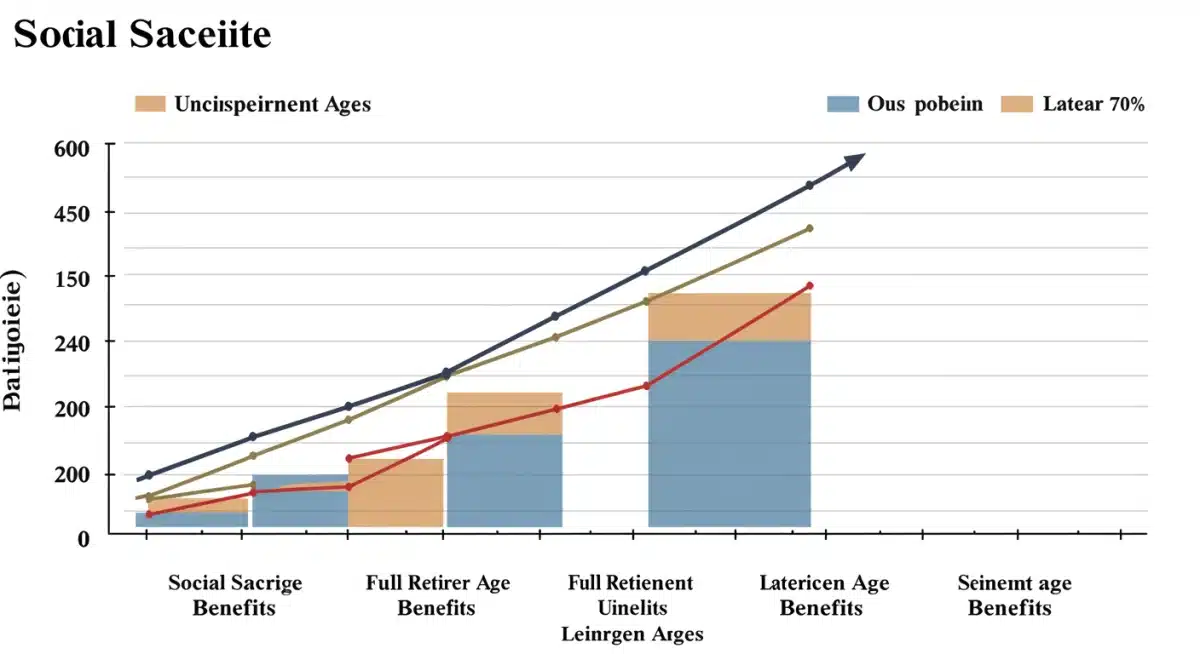Unlock 15% More: Your 2025 Social Security Benefits Guide

Maximizing Social Security benefits in 2025 involves strategic claiming decisions and understanding eligibility rules to potentially increase your retirement income by up to 15% through informed choices.
Are you looking to boost your retirement income? Understanding how to maximize social security benefits is crucial, especially as we approach 2025. This expert guide will walk you through the essential strategies and changes you need to know to potentially unlock up to 15% more in your Social Security payments, ensuring a more secure financial future.
Understanding Your Full Retirement Age (FRA)
Your Full Retirement Age (FRA) is a cornerstone of Social Security planning. It’s the age at which you’re entitled to receive 100% of your primary insurance amount (PIA). Claiming benefits before your FRA leads to a permanent reduction, while delaying past it can significantly increase your monthly payments.
Knowing your specific FRA is the very first step in crafting an effective claiming strategy. For most people born in 1960 or later, the FRA is 67. However, it varies based on your birth year, so it’s essential to confirm yours directly with the Social Security Administration (SSA).
Calculating Your Full Retirement Age
The SSA provides clear guidelines for determining your FRA. This age is not arbitrary; it was established to ensure the long-term solvency of the Social Security system while providing a framework for benefits distribution. Understanding this calculation helps you anticipate your maximum benefit potential.
- Born before 1937: FRA is 65
- Born between 1943-1954: FRA is 66
- Born in 1960 or later: FRA is 67
These age milestones are critical because they dictate the baseline for your benefit calculations. Claiming early means accepting less than your PIA, while delaying can result in substantial increases, making your FRA a pivotal decision point.
Impact of Early Claiming
Claiming Social Security benefits as early as age 62 might seem appealing, but it comes with a significant and permanent reduction in your monthly payments. This reduction can be as much as 30% if you claim at 62 instead of waiting until your FRA. While it provides immediate income, it often means sacrificing long-term financial security.
Therefore, carefully weigh the pros and cons of early claiming. Consider your current financial needs, other retirement savings, and your health status. An early claim can be beneficial if you have health issues or desperately need the income, but it’s generally not the optimal strategy for maximizing your lifetime benefits.
In summary, your Full Retirement Age is the foundation for all Social Security benefit calculations. Understanding it helps you make informed decisions about when to claim, balancing immediate needs with the desire to maximize your long-term retirement income.
The Power of Delayed Claiming
One of the most potent strategies to maximize social security benefits is delaying your claim past your Full Retirement Age (FRA). For every year you delay claiming benefits beyond your FRA, up to age 70, your monthly payment increases by a certain percentage, known as Delayed Retirement Credits (DRCs). These credits can significantly boost your annual income in retirement.
This increase is substantial and permanent, making delayed claiming a powerful tool for those who can afford to wait. It’s an investment that pays dividends for the rest of your life, providing a higher guaranteed income stream than almost any other investment vehicle.
Understanding Delayed Retirement Credits
Delayed Retirement Credits are a key component of the Social Security system designed to incentivize later claiming. For individuals born in 1943 or later, the annual increase is 8% per year. This means if your FRA is 67 and you wait until 70, your benefit will be 124% of your PIA.
- Age 62: Up to 30% reduction
- Full Retirement Age (e.g., 67): 100% of PIA
- Age 70: 124% of PIA (for those with FRA 67)
The cumulative effect of these credits can lead to a substantial difference in total lifetime benefits, especially if you live a long and healthy life. This strategy is particularly effective for individuals who have other sources of income to cover expenses between their FRA and age 70.
When Delaying Makes Sense
Delaying your Social Security claim isn’t for everyone, but it offers significant advantages in specific situations. If you are in good health and expect to live a long life, the increased monthly payments will likely outweigh the years of missed benefits. This is especially true if you or your spouse has a family history of longevity.
Furthermore, if you are still working and have sufficient income, or if you have other retirement savings (like 401(k)s or IRAs) to draw from, delaying your claim allows your Social Security benefit to grow. This can provide a crucial financial safety net later in life, particularly as other retirement funds might fluctuate with market conditions.
Overall, delayed claiming is a powerful strategy to significantly increase your monthly Social Security benefits. By understanding DRCs and assessing your personal circumstances, you can make an informed decision that optimizes your retirement income for the long term.

Strategic Spousal and Survivor Benefits
Spousal and survivor benefits offer another critical avenue to maximize social security benefits within a family unit. These benefits are designed to provide financial support to spouses and surviving family members, and understanding how they work can significantly impact a couple’s overall retirement income. These aren’t just for individuals; they are powerful tools for families.
Navigating these rules requires careful planning, especially when coordinating claims between partners. The right strategy can mean thousands of dollars more in lifetime benefits for a couple or a surviving spouse.
Spousal Benefit Rules
If you are married, divorced, or widowed, you might be eligible for spousal benefits based on your partner’s work record. A spouse can claim up to 50% of their partner’s Full Retirement Age (PIA) benefit. However, claiming your spousal benefit before your own FRA will result in a reduced amount.
One common strategy involves one spouse claiming their own benefit while the other claims a spousal benefit, then later switching to their own higher benefit if they delayed. This intricate dance requires precise timing and a thorough understanding of the rules.
- To claim spousal benefits, your spouse must generally be receiving their own benefits.
- You can claim spousal benefits even if you never worked under Social Security.
- If you are eligible for both your own benefit and a spousal benefit, the SSA will pay you the higher of the two.
It’s important to note that the rules around spousal benefits can be complex, especially with recent changes to claiming strategies. Consulting with a financial advisor specializing in Social Security can clarify your options.
Survivor Benefits for Widows and Widowers
Survivor benefits are a crucial safety net for widows and widowers. As a surviving spouse, you can receive up to 100% of your deceased spouse’s Social Security benefit, provided you claim at your own Full Retirement Age or later. Claiming survivor benefits early, as early as age 60 (or 50 if disabled), will result in a reduced benefit.
A common strategy for surviving spouses is to claim survivor benefits first, allowing their own retirement benefits to grow until age 70, then switch to their own higher benefit. This allows for an immediate income stream while maximizing their future payments.
In conclusion, spousal and survivor benefits are vital components of Social Security planning. By strategically coordinating claims and understanding eligibility, couples and surviving family members can significantly enhance their financial security in retirement.
Working While Receiving Benefits in 2025
For many, retirement doesn’t mean a complete stop to working. However, earning income while receiving Social Security benefits, especially before your Full Retirement Age (FRA), can impact your monthly payments. Understanding the earnings limits for 2025 is crucial to avoid unexpected reductions and to effectively maximize social security benefits even while working part-time.
The rules are designed to balance the need for supplementary income with the system’s aim of providing retirement support. Being aware of these thresholds allows you to plan your work schedule and income strategically.
Earnings Limits Before FRA
If you are below your FRA and receive Social Security benefits, there’s an annual earnings limit. For 2025, while the exact figures will be released later, it typically increases slightly each year. If your earnings exceed this limit, a portion of your benefits will be temporarily withheld. For context, in 2024, if you are under FRA, the SSA deducts $1 from your benefits for every $2 you earn above the annual limit ($22,320).
It’s not a permanent loss; the withheld benefits are added back to your payment calculation once you reach your FRA, effectively increasing your monthly amount from that point forward. However, it’s important to be aware of the immediate impact.
- Exceeding the limit results in benefit withholding.
- The withheld amount is credited back at FRA.
- Careful planning can help you stay below the limit if immediate full benefits are desired.
Earnings Limits in the Year You Reach FRA
In the year you reach your FRA, the earnings limit is higher, and the withholding rules are more lenient. For example, in 2024, the limit for the year you reach FRA is $59,520, and the SSA deducts $1 for every $3 you earn above this limit until the month you reach your FRA. Once you hit your FRA, there are no longer any earnings limits.
This means you can earn as much as you want without any reduction to your Social Security benefits once you’ve reached your full retirement age. This flexibility can be a significant advantage for those who wish to continue working part-time or even full-time while enjoying their full Social Security entitlement.
In conclusion, working while receiving Social Security benefits requires careful attention to earnings limits. By understanding these thresholds and how they apply to your situation, you can strategically manage your income to avoid benefit reductions and still enjoy the financial security Social Security provides.
Navigating Cost-of-Living Adjustments (COLAs)
The Cost-of-Living Adjustment (COLA) is a critical feature of Social Security designed to help benefits keep pace with inflation. Each year, the Social Security Administration (SSA) announces a COLA, which adjusts monthly benefits to reflect changes in the cost of living. Understanding how COLAs are determined and their impact is essential for anyone looking to maximize social security benefits and maintain their purchasing power in retirement.
While the COLA is an automatic adjustment, its size can vary significantly from year to year, depending on economic conditions. Staying informed about these adjustments is key to accurate financial planning.
How COLA is Calculated
The COLA is based on the Consumer Price Index for Urban Wage Earners and Clerical Workers (CPI-W). Specifically, the SSA compares the average CPI-W for the third quarter of the current year with the average for the third quarter of the previous year that a COLA was effective. The percentage increase, if any, determines the COLA for the following year.
This calculation ensures that beneficiaries’ purchasing power is protected against inflation. A higher inflation rate generally leads to a larger COLA, providing a necessary boost to benefits during periods of rising costs.
- COLA directly impacts your monthly benefit amount.
- It’s tied to the CPI-W, reflecting inflation.
- Annual announcements provide transparency for beneficiaries.
Impact of COLAs on Future Benefits
COLAs don’t just affect current beneficiaries; they also play a role in the calculation of future benefits for those who haven’t yet claimed. The annual adjustments ensure that the value of your earnings record, which determines your primary insurance amount (PIA), keeps up with inflation over your working years. This means that delaying your claim not only earns you Delayed Retirement Credits but also benefits from the cumulative effect of COLAs on your earnings record.
As 2025 approaches, anticipating the COLA will be an important factor for retirees and those nearing retirement. While the exact percentage is unknown until later in the year, it’s a vital element in projecting future income and ensuring your retirement funds stretch further.
In conclusion, COLAs are a fundamental aspect of Social Security, safeguarding the real value of your benefits. By understanding their calculation and impact, you can better plan your retirement finances and ensure your Social Security income maintains its purchasing power over time.
Understanding the Tax Implications of Benefits
While receiving Social Security benefits provides crucial income in retirement, it’s important to recognize that a portion of these benefits may be taxable. Understanding the tax implications is essential for effective financial planning and to truly maximize social security benefits by avoiding unexpected tax liabilities. Many retirees are surprised to learn that their hard-earned benefits aren’t entirely tax-free.
The taxation of Social Security benefits depends on your combined income, which includes your adjusted gross income, tax-exempt interest, and half of your Social Security benefits. This calculation determines how much, if any, of your benefits will be subject to federal income tax.
Federal Income Tax on Benefits
Up to 85% of your Social Security benefits can be subject to federal income tax, depending on your combined income. The thresholds for taxation are as follows:
- If your combined income is between $25,000 and $34,000 (single filer) or $32,000 and $44,000 (married filing jointly), up to 50% of your benefits may be taxable.
- If your combined income exceeds $34,000 (single filer) or $44,000 (married filing jointly), up to 85% of your benefits may be taxable.
These thresholds are not indexed for inflation, meaning more and more retirees find their benefits subject to taxation over time. Strategic planning, such as managing withdrawals from traditional IRAs versus Roth IRAs, can help control your combined income and potentially reduce your tax burden.
State Income Tax on Benefits
In addition to federal taxes, some states also tax Social Security benefits. While the majority of states do not, it’s crucial to check the specific tax laws of your state of residence. As of recent data, states like Colorado, Connecticut, Kansas, Minnesota, Missouri, Montana, Nebraska, New Mexico, Rhode Island, Utah, Vermont, and West Virginia tax Social Security benefits to some extent, though many offer exemptions.
Understanding these state-specific rules is vital, especially if you are considering relocating in retirement. A move to a state that doesn’t tax Social Security benefits could result in significant savings over your retirement years.
In conclusion, the tax implications of Social Security benefits are a critical consideration for retirees. By understanding both federal and state tax rules, you can implement strategies to manage your combined income and minimize your tax liability, thereby effectively preserving more of your hard-earned benefits.
Future Outlook and Legislative Changes for 2025
The landscape of Social Security is dynamic, often influenced by legislative discussions and economic trends. While the core rules for 2025 are largely set, it’s always prudent to monitor potential legislative changes that could impact future benefits. Staying informed about these discussions is a proactive step to ensure you continue to maximize social security benefits amidst evolving policies.
Discussions often revolve around ensuring the long-term solvency of the trust funds, which may lead to proposals for adjustments to benefits, claiming ages, or taxation. Being aware of these debates allows for better long-term financial planning.
Potential Legislative Reforms
Various proposals periodically surface regarding Social Security reform. These can range from increasing the Full Retirement Age, adjusting the COLA calculation, or altering the taxation of benefits. While no major changes are immediately anticipated for 2025, these discussions are ongoing and can shape the future of the program.
For example, some proposals suggest means-testing benefits for higher earners, while others advocate for increasing the Social Security tax cap. Each potential change carries significant implications for current and future beneficiaries, underscoring the importance of vigilance.
- Legislative changes could affect claiming age.
- COLA calculation methods might be revised.
- Taxation thresholds are subject to debate.
Staying Informed on Policy Changes
To effectively plan your retirement and maximize your Social Security benefits, it’s crucial to stay informed about any potential policy changes. Reliable sources for information include the Social Security Administration’s official website, reputable financial news outlets, and non-partisan research organizations.
Engaging with a financial advisor who specializes in retirement planning and Social Security can also provide personalized insights and help you adapt your strategy to any new legislation. Proactive engagement with this information ensures you’re always making the best decisions for your financial future.
In summary, while the immediate outlook for Social Security in 2025 seems stable, it’s vital to remain aware of ongoing legislative discussions. By closely monitoring potential reforms and staying informed, you can ensure your strategies to maximize Social Security benefits remain robust and adaptable to future changes.
Expert Tips for Maximizing Your 2025 Benefits
Beyond the fundamental strategies of delayed claiming and understanding spousal benefits, several expert tips can help you further optimize and maximize social security benefits for 2025. These often involve a holistic view of your financial situation and careful coordination with other retirement assets. Every percentage point gained adds up over a lifetime.
These tips are designed to provide a more nuanced approach, addressing specific situations and leveraging less commonly known rules to your advantage.
Review Your Earnings Record Annually
It’s crucial to regularly review your Social Security earnings record. Mistakes can occur, and an incorrect record could lead to lower benefits. The SSA provides an online portal where you can check your reported earnings against your pay stubs or W-2 forms. Any discrepancies should be reported and corrected promptly.
A complete and accurate earnings record ensures that your Primary Insurance Amount (PIA) is calculated correctly, forming the true basis for your future benefits. This simple annual check can prevent significant losses over your retirement.
Coordinate with Your Spouse
For married couples, coordinating claiming strategies can yield substantial benefits. This often involves one spouse claiming early to provide immediate income while the other delays until age 70 to maximize their individual benefit. When the higher earner delays, it also boosts the potential survivor benefit for the surviving spouse.
Consider scenarios where one spouse has a significantly higher earnings record. Strategically delaying the higher earner’s claim can provide a much larger combined lifetime benefit, ensuring greater financial security for both partners.
Consider Your Longevity and Health
Your personal health and family history of longevity should heavily influence your claiming decision. If you anticipate living a long life, delaying benefits until age 70 typically provides the highest cumulative payout. The breakeven point for delayed claiming versus early claiming often falls in your late 70s or early 80s.
However, if you have health concerns or a shorter life expectancy, claiming earlier might be the more beneficial option. The goal is to maximize your total lifetime benefits, which requires an honest assessment of your health outlook.
These expert tips, combined with a solid understanding of the core Social Security rules, empower you to make highly informed decisions. By taking a proactive and personalized approach, you can effectively maximize your Social Security benefits and secure a more comfortable retirement in 2025 and beyond.
| Key Strategy | Brief Description |
|---|---|
| Delayed Claiming | Boosts monthly benefits by 8% per year past FRA up to age 70. |
| Spousal Benefits | Claim up to 50% of spouse’s PIA; coordinate for maximum family income. |
| Monitor Earnings Limits | Avoid benefit reduction if working before Full Retirement Age. |
| Review Earnings Record | Ensure accuracy of your work history for correct benefit calculation. |
Frequently Asked Questions About Social Security Benefits
Your Full Retirement Age (FRA) depends on your birth year. For individuals born in 1960 or later, it is 67. If you were born between 1943 and 1954, your FRA is 66. It’s crucial to confirm your specific FRA with the SSA to accurately plan your claiming strategy and avoid benefit reductions.
For every year you delay claiming benefits past your Full Retirement Age, up to age 70, your monthly payment increases by 8% due to Delayed Retirement Credits. This means if your FRA is 67, waiting until 70 can result in a 24% increase (8% per year for three years) over your primary insurance amount.
Yes, if you are below your Full Retirement Age and earn above a certain annual limit, your Social Security benefits may be temporarily reduced. For example, in 2024, if you earn over $22,320, $1 is deducted for every $2 earned above the limit. These withheld benefits are typically added back to your payments once you reach your FRA.
A portion of your Social Security benefits may be subject to federal income tax, depending on your combined income. Up to 85% of benefits can be taxed. Additionally, some states also tax Social Security benefits, so it’s important to check your state’s specific tax laws and plan accordingly to minimize your tax liability.
COLAs are annual adjustments designed to help your Social Security benefits keep pace with inflation. They are based on changes in the Consumer Price Index for Urban Wage Earners and Clerical Workers (CPI-W). COLAs increase your monthly benefit amount, helping preserve your purchasing power throughout retirement, and are also factored into future benefit calculations.
Conclusion
Navigating the intricacies of Social Security benefits can seem daunting, but with the right knowledge and strategic planning, you have the power to significantly enhance your retirement income. By understanding your Full Retirement Age, embracing the power of delayed claiming, coordinating spousal and survivor benefits, being mindful of earnings limits, and staying informed about COLAs and tax implications, you can truly maximize social security benefits for 2025 and beyond. Proactive engagement with these strategies offers the potential to unlock up to 15% more in your monthly payments, securing a more comfortable and financially stable retirement.





